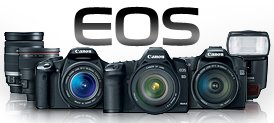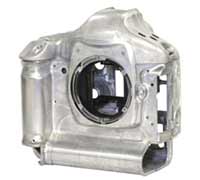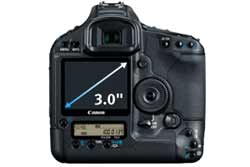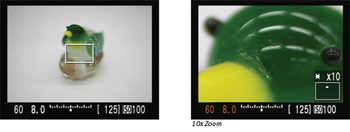


Product Description
The Canon EOS-1Ds Mark III is an engineering tour de force which, true to the EOS-1 legacy, redefines the state of the art in no uncertain terms. An entirely new 21.1-megapixel full-frame Canon CMOS sensor delivers astounding image quality and creates new photographic possibilities. Dual "DIGIC III" Image Processors work in tandem to speed up data handling and camera operation, while further refining imaging performance. Tough, high-durability body and shutter designs, combined with the unique EOS Integrated Cleaning System, set new standards for professional dependability. Cutting-edge features-such as a large 3.0-inch LCD monitor with Live View Function, and a fast, precise 45-point AF system-make the EOS-1Ds Mark III powerful and versatile. And, of course, the EOS-1Ds Mark III is part of the unparalleled EOS System, which, with more than 50 EF lenses, 15 interchangeable focusing screens, and extensive wireless remote control and lighting accessories, is the most advanced and powerful digital photography system in the world.
Canon EOS-1Ds Mark III Highlights
Superb Image Quality
The EOS-1Ds Mark III incorporates Canon's newest CMOS sensor, which delivers approximately 21.1 effective megapixels (5,632 x 3,750 pixels). The recording area of the sensor is 36 x 24mm, which is equivalent to the full-frame size of the 35mm film format. The tremendous pixel count delivers high-resolution images of exacting precision, with Photoshop file sizes over 60MB for outstanding quality at large print sizes and post-processing cropping flexibility. Despite the higher pixel density, Canon CMOS sensor technology ensures exceptionally low noise and the widest usable ISO range* (from 50 to 3200, using ISO range extension).
 |
Activated via a Custom Function on the EOS-1Ds Mark III, the unique Highlight Tone Priority feature takes full advantage of the camera's 14-bit per channel digital conversion to provide smoother gradations from the grays to the highlights and preserve greater detail in image highlight areas — a perennial problem for digital photographers, especially those who work in bright sunlight or contrasty studio lighting. Highlight Tone Priority expands the available range of capture in the highlights, yet it exacts no penalties in either shadow detail or other aspects of image capture.
 |
Whereas most other digital cameras use 12-bit A/D (analog-to-digital) converters, the EOS-1Ds Mark III employs superior 14-bit per channel converters to process the output of the imaging sensor. In each color channel, this means there are 16,384 distinct brightness steps from the darkest to brightest tone (vs. 4,096 previously). This ensures smoother tonal transitions and more natural gradations. RAW images are recorded at the full 14 bit, and once processed will preserve the entire range of tones when opened in Photoshop's 16-bit color space.
"Picture Style" settings
With another great feature, Picture Style technology, photographers can recreate characteristics of their favorite films. Color, saturation, sharpness and contrast settings create noticeable variation in the saved image. In addition to six preset Picture Style settings (Standard, Portrait, Landscape, Neutral, Faithful and Monochrome), users can create three additional settings for their particular photographic style.
Picture Style settings are applied directly to JPEG images, giving tremendous flexibility to shooters who prefer the ease of JPEG files. If RAW images are processed in Canon's Digital Photo Professional software (v. 3.2 or higher) or RAW Image Task software, the versatile Picture Style settings can be modified or completely changed in the computer, without affecting the original file.
Dual "DIGIC III" Image Processor for excellent image quality and processing speed. spacer
 |
Developed to maximize performance between the capture and recording stages of digital photography, the EOS-1Ds Mark III's Dual "DIGIC III" Image Processors work in parallel to dramatically enhance image quality and deliver the speed and power needed to combine 21.1 million pixels and 5 frames per second. The latest-generation DIGIC III Image Processor works in concert with Canon's CMOS sensor to achieve even higher levels of performance. The entire electronic system is totally re-designed, giving the camera its incredible combination of speed and image quality. Digital noise is significantly reduced in shadow areas, and color reproduction is superior.
Live View Function capabilities, displayed on the large 3.0-inch LCD monitor. spacer The EOS-1Ds Mark III features a sophisticated Live View Function, which makes the LCD monitor a real-time finder. When the Live View Function is enabled, the reflex mirror is locked up and the shutter opens. The image output from the CMOS sensor will be displayed in real time on the LCD monitor with 100 percent coverage. A selectable portion of the image can be magnified by 5x or 10x to aid in precise manual focusing. Focus, exposure check, composing, and shooting can all be accomplished in this mode. There is also a grid overlay option, perfect for architectural photography.
Live View Function is convenient for tripod-mounted shooting, macro work, precise shooting with Canon's Tilt-Shift lenses, and many other situations in which it is a physical strain to keep the eye at the viewfinder. The image can also be displayed on a TV monitor, which is ideal for showing photographs, as they are being composed, to clients and portrait subjects.
 |
At 3.0 inches diagonal, the EOS-1Ds Mark III's LCD monitor is exceptionally large. The big, clear image is ideal for Live View Function. It also makes it easier than ever to confirm capture, check memory card contents, confirm shooting parameters, and access menu options.
 |
Using Canon EOS Utility software, photographers can check and adjust focus and composition in real time on their personal computers, whether in the studio or on location. The camera can even be fired remotely from the computer. Connection between the camera and computer can be done via USB cable or, with the optional WFT-E2A Wireless Transmitter, via wireless LAN or an Ethernet connection.
Outstanding durability thanks to a shutter durability-tested to 300,000 cycles, dust- and water-resistant design, and EOS Integrated Cleaning System
Unprecedented shutter durability
The EOS-1Ds Mark III features an improved heavy-duty shutter that has been durability tested to 300,000 cycles. The camera thus provides long service life and inspires the all-important confidence for the professional that comes from the knowledge that the shutter will perform on demand.
 |
Extensive weatherproofing ensures superior reliability, even when shooting in harsh environments. Rubber gaskets are used at nearly every joint and seam--including around the battery compartment cover, memory card door, and flash shoe--to keep out moisture and dust.
EOS Integrated Cleaning System
Photographers who must change lenses in dusty environments will find the advanced Canon EOS Integrated Cleaning System a tremendous time saver. Dust that settles on the low-pass filter is removed using ultrasonic vibration. This Self Cleaning Sensor Unit is automatically activated whenever the camera is powered on or off. (It can also be manually activated.) A special collar positioned around the sensor collects the loosened dust. Dust particles can also be automatically removed via software. By shooting a plain white subject, the photographer can acquire dust position data called "Dust Delete Data" that is transmitted along with each subsequent image (whether JPEG or RAW). Canon Digital Photo Professional (DPP) v.3.2 or higher software can then be used to manually or automatically erase the dust spots, before the image ever gets to Photoshop or a similar image-editing program.
 |
Dust that has been missed by the Integrated Self-Cleaning Sensor Unit can also be erased with software included in Digital Photo Professional (DPP) Version 3.2 or higher. The EOS-1Ds Mark III's imaging sensor is able to single out the dust particles on its surface, then plots out their location coordinates within the image. This data is transmitted along with the image, whether JPEG or RAW, and can be either manually or automatically erased in Canon's DPP software. This added software option ensures the cleanest possible image, perfect for printing or archiving.
Dust Delete Data Detection
Dust that has been missed by the Integrated Self-Cleaning Sensor Unit can also be erased with software included in Digital Photo Professional (DPP) Version 3.2 or higher. The EOS-1Ds Mark III's imaging sensor is able to single out the dust particles on its surface, then plots out their location coordinates within the image. This data is transmitted along with the image, whether JPEG or RAW, and can be either manually or automatically erased in Canon's DPP software. This added software option ensures the cleanest possible image, perfect for printing or archiving.
Up to 5 fps, burst rate up to 12 consecutive RAW images or 56 full-resolution JPEGs
Impressive Shooting Performance
The new 21.1-megapixel full-frame CMOS sensor generates a tremendous volume of data that must be processed by the camera. Thanks to unparalleled Canon high-speed data management technologies--including the use of dual DIGIC III processor chips--the EOS-1Ds Mark III delivers full-resolution performance without sacrificing all-important shooting speed or camera responsiveness. Maximum continuous shooting is 5 fps, and up to 56 consecutive full-resolution JPEG or 12 RAW images can be captured in a single continuous burst (at shooting speeds up to the full 5 fps).
 |
Compatible with UDMA CF Cards
The EOS-1Ds Mark III supports the latest, faster UDMA (Ultra Direct Memory Access) CF memory cards. UDMA-compliant CF cards offer twice the data transfer rate of conventional cards, further enhancing the shooting and post-shooting performance of the EOS-1Ds Mark III.
Fast and precise AF system
The EOS-1Ds Mark III incorporates new Canon AF technologies that bring about improvement in key performance areas. The extraordinary 45-point high-density area AF system provides not only the industry's largest continuous AF coverage area, but also the greatest range of control over focusing point selection. The focusing point can be selected automatically by the camera (based on high-speed microcomputer analysis of image content), or users can manually select any of the 19 high precision cross-type AF points, which can be complemented by 26 additional Assist Points for fast, accurate focusing.
 |
A separate processing unit devoted solely to autofocus calculation is a key in the EOS-1Ds Mark III's superb AF performance. The One-Shot AF mode is ideal for more static subjects. The camera rapidly selects the optimum focusing point, and the subject is instantly brought into focus even if it is off-center. The AI Servo AF mode is excellent for moving subjects. Aided by a the camera's outstanding new AF sensor and powerful processing abilities, it precisely tracks subject movement, even when shooting continuously at 5 fps. Even with erratic or rapid subject movement, the photographer can concentrate solely on image composition.
New Custom Functions aid the photographer in choosing default focusing points, as well as changing the size of a manually-selected AF point, making this not only the fastest, but also the most customizable AF system on the planet.
Compatible with wireless file transmitter WFT-E2A, extensive remote control accessories, and 15 different interchangeable Ec-series focus screens. spacer
Wireless File Transmitter WFT-E2A
A significant redesign of Canon's earlier wireless transmitter, the new WFT-E2A is much more compact and provides a broader range of useful professional functions. It integrates elegantly with the EOS-1Ds Mark III, is powered by the camera body, and is as durable and weather-resistant as the camera itself. Not only can the camera's files be sent to a compatible computer in three different wireless modes, but you can even remote-control the camera, wirelessly, from your computer.
The WFT-E2A can be easily set up to operate in wireless LAN (802.11b or g) environments. A new, more efficient built-in antenna enables wireless communication with host computers or access points up to 492 ft./150m) away. Where wireless access is limited, the WFT-E2A can be used for conventional (wired) Ethernet connection.
USB 2.0 Hi-Speed host capability enables the use of external storage media, such as a USB hard drive, for memory card backup, quick copying of files, or just vastly expanded shooting capacity. Images shot on the camera can be recorded directly to the hard drive. The WFT-E2A can also communicate with various third-party GPS devices connected via USB. Location coordinates, precise Universal Time Code, and altitude can be sent to the camera and added to each image's original shooting data.
Interchangeable Focusing Screens
The EOS-1Ds Mark III is equipped with the Laser Matte Ec-C IV focusing screen, which provides superior optical performance. Background blur appears more natural, and graininess and flare are reduced. At the same time, the finder is brighter, especially at the edges and corners. As with all EOS-1 Series SLRs, the EOS-1Ds Mark III gives a photographer the widest choice of interchangeable focusing screens. Currently, there are 15 different Ec-series screens.
EF Lenses
Of course the EOS-1Ds Mark III is compatible with all Canon lenses in the EF lineup, ranging from ultra-wide angle to super telephoto lenses. Canon lenses employ advanced optical expertise and micron-precision engineering to deliver unprecedented performance in all facets of the photographic process. Special optical technologies, such as aspherical optics and fluorite elements are featured in the universally acclaimed L Series lenses. A new addition to the L Series is the EF 14mm f/2.8L II USM lens. With a 114° angle of view that can be captured with the EOS-1Ds Mark III's full-frame sensor. Unlike a fisheye lens, this stunning new ultra-wide lens is totally corrected for linear distortion, and offers even better sharpness and contrast than its predecessor, Through Canon lenses, photographers can truly maximize the quality and liberating performance of the EOS-1Ds Mark III.
 |
Flash Photography
The EOS-1Ds Mark III features the acclaimed E-TTL II flash metering system. With any of the flashes in the EX Speedlite line, E-TTL II provides reliable flash output whether shooting fill-in flash pictures in sunlight, or using flash in total darkness. The camera's new 63-zone evaluative metering sensor is also used for flash metering -- giving even finer metering command of the image area. If you prefer a broader area for flash metering, Custom Function II-4-1 allows shifting flash metering so that all 63 zones of the sensor are used equally to calculate flash exposures.
Canon's Speedlite 580EX II is perfectly suited to the EOS-1Ds Mark III. It has improved reliability of communications through the direct contacts, has a metal flash "foot," and is dust- and water-resistant as with the EOS-1Ds Mark III. Other new features include a PC socket on the flash unit, and an external metering sensor for non-TTL auto flash if desired. With the EOS-1Ds Mark III, you can set most flash settings directly from the camera's menus. It has the same power as the previous Speedlite 580EX (maximum guide number of 190 ft./58m at ISO 100), and with its built-in wide panel, can be used with lenses as wide as 14mm on Canon's full-frame cameras. It includes an AF-assist Beam, which works in conjunction with the EOS-1Ds Mark III's focusing system, and automatically sends color temperature information to the camera when the flash fires, for more accurate white balance rendition with flash photography.
Software
Canon's EOS Digital Solution Disk (Version 15.0) features powerful software programs designed to extend the EOS experience to the computer. These include Canon's ZoomBrowser EX for Windows® (Version 5.8), ImageBrower for Macintosh® OS X (Version 5.8), Digital Photo Professional (Version 3.2), Canon's EOS Utility (Version 2.0), RAW Image Task (Version 2.6), PhotoStitch, and PTP TWAIN Driver. Each application is designed to perfect captured images and streamline the digital workflow. ZoomBrowser EX v. 5.8 and Digital Photo Professional v. 3.0 for Windows are compatible with the new Windows Vista operating system, too.
Digital Photo Professional (Version 3.2) is an image processing program that enables high-speed RAW image processing, high-speed previewing for real-time image adjustment and support for sRGB, Adobe RGB and Wide Gamut RGB color spaces. Because it's CMS (Color Management System) compatible, Digital Photo Professional allows for easy image layout and printing in Adobe RGB in conjunction with Easy-PhotoPrint and PictBridge printers. It also features the Dust Delete Data Detection tool for cleaner images.
EOS Utility (Version 2.0) for Macintosh or Windows handles the connection between the camera and computer, whenever they're connected via USB. It allows remote controlled shooting from the computer, handles downloading of images from the camera to the computer, and allows seamless linking to either Canon's ZoomBrowser/ImageBrowser or Digital Photo Professional software once images have been copied to the hard drive. Furthermore, it's used to upload settings back into a USB-connected camera.
ZoomBrowser EX (Version 5.8) for Windows and ImageBrowser (Version 5.8) for Mac OS X are the easy, user-friendly options for viewing and editing of JPEG and even RAW image files. Both allow viewing of numerous types of images including finished TIFF and BMP files. Both also have a variety of search options for finding images, allow re-naming of single images or batches of files, and offer a variety of options for printing without using a separate image-editing program.
RAW Image Task (Version 2.6) is an integrated component of ZoomBrowser EX (Windows) or ImageBrowser (Mac). It allows processing of RAW images from EOS cameras, including the new EOS-1D Mark III, with a variety of adjustment possibilities. These options, as well as the overall color, contrast and "look" of RAW Image Task, closely mimic the characteristics of Canon's in-camera JPEG processing.
Product Description
The Canon EOS-1Ds Mark III is an engineering tour de force which, true to the EOS-1 legacy, redefines the state of the art in no uncertain terms. An entirely new 21.1-megapixel full-frame Canon CMOS sensor delivers astounding image quality and creates new photographic possibilities. Dual "DIGIC III" Image Processors work in tandem to speed up data handling and camera operation, while further refining imaging performance. Tough, high-durability body and shutter designs, combined with the unique EOS Integrated Cleaning System, set new standards for professional dependability. Cutting-edge features-such as a large 3.0-inch LCD monitor with Live View Function, and a fast, precise 45-point AF system-make the EOS-1Ds Mark III powerful and versatile. And, of course, the EOS-1Ds Mark III is part of the unparalleled EOS System, which, with more than 50 EF lenses, 15 interchangeable focusing screens, and extensive wireless, remote control and lighting accessories, is the most advanced and powerful digital photography system in the world. The EOS-1Ds Mark III incorporates Canon's newest CMOS sensor, which delivers approximately 21.1 effective megapixels (5,632 x 3,750 pixels). The recording area of the sensor is 36 x 24mm, which is equivalent to the full-frame size of the 35mm film format. The tremendous pixel count delivers high-resolution images of exacting precision, with Photoshop file sizes over 60MB for outstanding quality at large print sizes and post-processing cropping flexibility. Despite the higher pixel density, Canon CMOS sensor technology ensures exceptionally low noise and the widest usable ISO range (from 50 to 3200, using ISO range extension). Auto and Manual Focus Dimensions (W x H x D) - 6.1 x 6.3 x 3.1 in./156 x 159.6 x 79.9mm






























